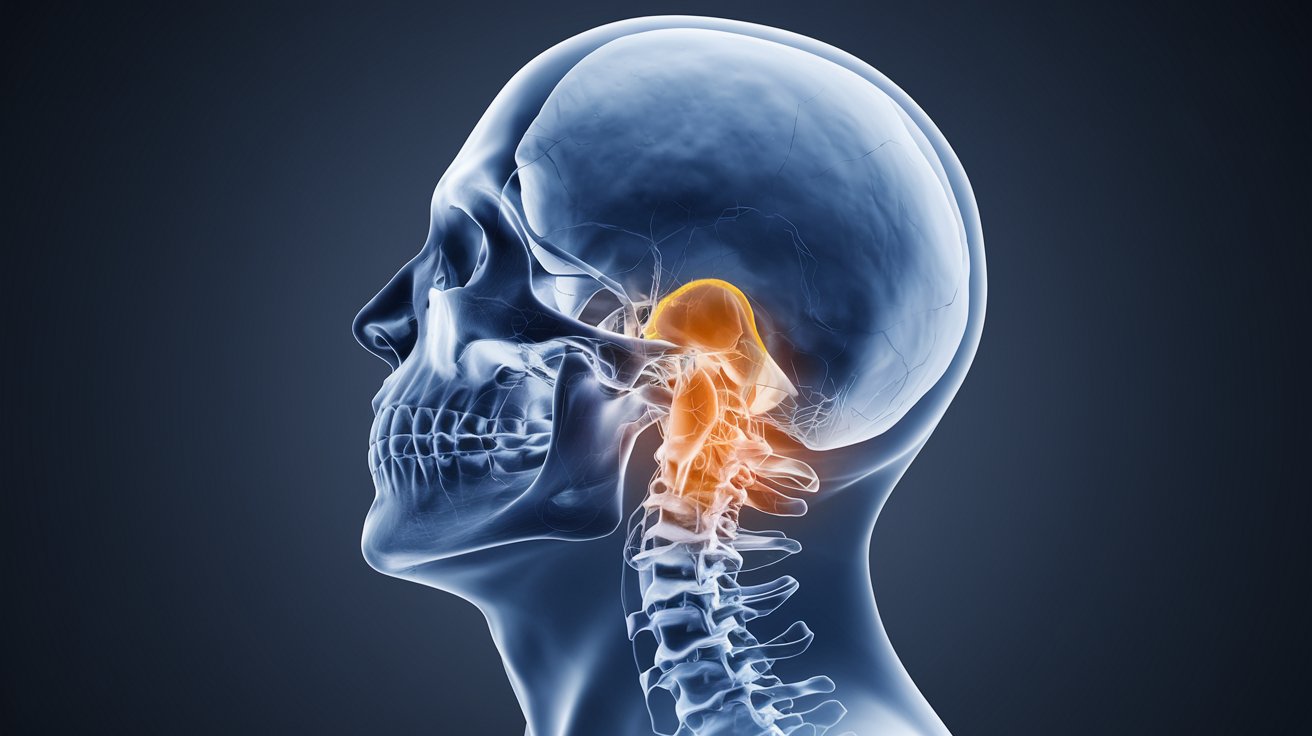
What is Basilar Impression Primary? Basilar impression primary is a rare condition where the base of the skull pushes down into the spinal canal. This can squeeze the brainstem and spinal cord, leading to various symptoms. These symptoms range from headaches and neck pain to severe issues like difficulty walking, talking, or even breathing. Diagnosing this condition often involves MRI or CT scans to get a clear picture of the skull and spine. Treatment can include wearing a neck brace or undergoing surgery to correct the problem. Understanding this condition is crucial for managing its symptoms and improving quality of life.
Understanding Basilar Impression
Basilar impression is a rare condition that affects the base of the skull and the upper spine. It can lead to serious neurological issues if not diagnosed and treated promptly. Here are some important facts to help you understand this condition better.
-
Definition and Etiology
Basilar impression involves the downward displacement of the posterior cranial fossa into the foramen magnum. This can be congenital or acquired due to trauma or degenerative diseases. -
Symptoms
Symptoms vary widely. Common ones include headaches, neck pain, dizziness, and balance issues. Severe cases may lead to quadriplegia or respiratory failure. -
Diagnosis
Diagnosis typically involves imaging studies. MRI is the most common method, providing detailed images of the posterior cranial fossa. CT scans are also useful, especially in emergencies.
Types and Causes
Basilar impression can be classified into different types based on its origin. Understanding these can help in determining the appropriate treatment.
-
Classification
There are two main types: congenital and acquired. Congenital cases often come with other anomalies, while acquired cases result from trauma or degenerative conditions. -
Congenital Causes
Congenital basilar impression is linked to genetic conditions affecting the craniovertebral junction, such as Klippel-Feil syndrome or Chiari malformation. -
Acquired Causes
Acquired basilar impression can result from trauma, osteoporosis, rheumatoid arthritis, and other degenerative diseases. These conditions weaken the bony structures, making them more susceptible to deformation.
Clinical Presentation and Neurological Deficits
The symptoms and neurological deficits associated with basilar impression can be severe and life-altering. Here’s what you need to know.
-
Clinical Presentation
Patients may experience symptoms ranging from mild neck pain and headaches to severe neurological deficits. The severity often correlates with the degree of impression and affected structures. -
Neurological Deficits
Compression of the spinal cord can result in quadriplegia, while brainstem compression can lead to ataxia, dysarthria, and respiratory failure. The extent of deficits depends on the degree of impression.
Imaging and Treatment Options
Imaging studies are crucial for diagnosing basilar impression, and treatment options vary based on the severity and underlying cause.
-
Imaging Findings
MRI is the preferred imaging method due to its ability to visualize both soft tissue and bony structures. High-resolution CT scans can provide detailed images of the bony structures and help identify associated anomalies. -
Treatment Options
Treatment depends on the underlying cause and severity of symptoms. Conservative management may involve cervical collars or bracing. Surgical intervention is often required to correct bony deformities and relieve pressure on neural structures.
Surgical Techniques and Complications
Surgical intervention is often necessary for severe cases. However, it comes with its own set of risks and complications.
-
Surgical Techniques
Surgical techniques aim to correct bony deformities and relieve pressure on neural structures. Procedures like posterior occipitocervical fusion or occipitalization of the atlas are commonly performed. -
Complications
Surgical intervention carries potential complications, including infection, nerve damage, and cervical spine instability. Postoperative care is crucial to prevent these complications.
Prognosis and Rehabilitation
The prognosis for basilar impression varies, and rehabilitation plays a critical role in recovery.
-
Prognosis
Prognosis depends on the extent of the impression and the underlying cause. Mild cases may respond well to conservative management, while severe cases may require surgical intervention. -
Rehabilitation
Rehabilitation is essential for recovery. Physical therapy can improve coordination and balance, while occupational therapy assists with daily activities. Speech therapy may be necessary for patients with dysarthria.
Genetic Considerations and Epidemiology
Understanding the genetic implications and epidemiology of basilar impression can help in early diagnosis and treatment.
-
Genetic Considerations
Basilar impression can have genetic implications, especially in cases associated with congenital anomalies like Klippel-Feil syndrome. Genetic counseling may be necessary for families with a history of these conditions. -
Epidemiology
Basilar impression is rare, and its exact incidence is difficult to determine. It is more commonly seen in populations with genetic conditions or degenerative diseases.
Pathophysiology and Clinical Evaluation
Understanding the pathophysiology and clinical evaluation methods can aid in better management of basilar impression.
-
Pathophysiology
The condition involves the downward displacement of the posterior cranial fossa into the foramen magnum, compressing the brainstem and spinal cord. The extent of compression depends on the degree of impression. -
Clinical Evaluation
Clinical evaluation involves a thorough history and physical examination. Imaging studies confirm the diagnosis and assess the extent of the impression. Neurological exams help identify specific deficits.
Management Strategies and Future Directions
Effective management strategies and future research can improve outcomes for patients with basilar impression.
-
Management Strategies
Management includes both conservative and surgical approaches. Conservative management may involve cervical collars or bracing, while surgical intervention corrects bony deformities and relieves pressure on neural structures. -
Future Directions
Future research aims to develop advanced imaging techniques and minimally invasive surgical procedures. Understanding the genetic causes of congenital basilar impression may lead to better treatment options.
Final Thoughts on Basilar Impression
Basilar impression is a rare but serious condition where the posterior cranial fossa moves downward into the foramen magnum, compressing the brainstem and spinal cord. Symptoms range from headaches and neck pain to severe neurological deficits like quadriplegia and respiratory failure. Diagnosis often involves MRI and CT scans, while treatment can be conservative or surgical, depending on severity. Congenital causes include genetic conditions like Klippel-Feil syndrome, while acquired causes involve trauma and degenerative diseases. Surgical techniques aim to correct bony deformities and relieve neural pressure, though complications can arise. Rehabilitation is crucial for improving quality of life post-treatment. Understanding the etiology, symptoms, and treatment options is key for effective management. Early intervention can significantly improve outcomes, making awareness and timely diagnosis essential.
Was this page helpful?
Our commitment to delivering trustworthy and engaging content is at the heart of what we do. Each fact on our site is contributed by real users like you, bringing a wealth of diverse insights and information. To ensure the highest standards of accuracy and reliability, our dedicated editors meticulously review each submission. This process guarantees that the facts we share are not only fascinating but also credible. Trust in our commitment to quality and authenticity as you explore and learn with us.


